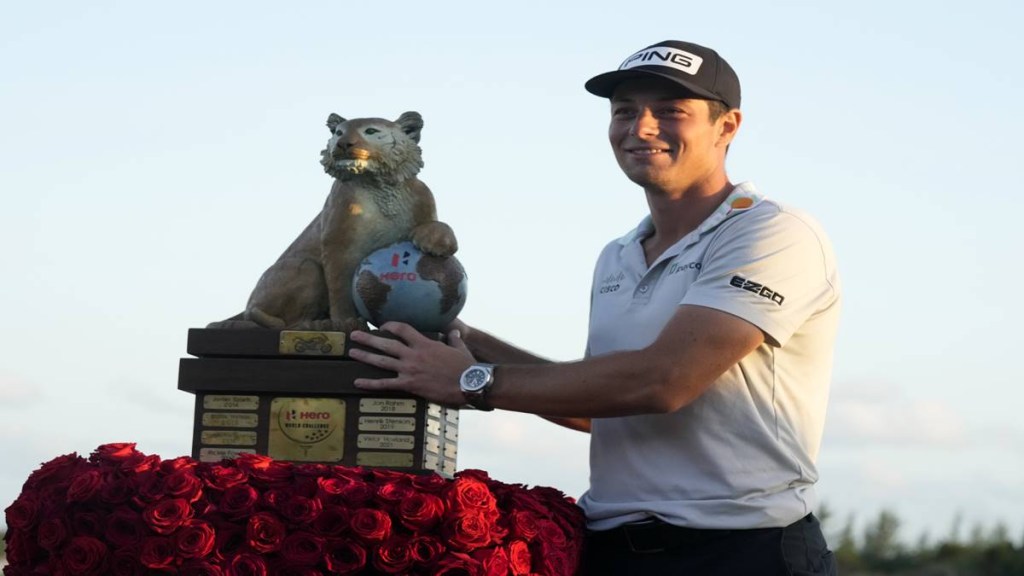It can be done. It is possible to build a world-class golf swing watching instructional videos, using a full-length mirror, and a video camera. Just look at Viktor Hovland: the Norwegian lad honed his golf swing while being sequestered indoors during the Scandinavian country’s long dark winter. Hovland is 23–part of Gen-Z which hasn’t known a world without the internet. For this tech-native generation, YouTube has always been the primary source of informational and educational video content.
Not that we older folk don’t watch golf instruction videos. In fact, those might well have been the very first channels I subscribed to on digital content platforms. Like most weekend golfers watching slow-motion golf swings of pros and instructional videos is my favourite indoor pastime. I’ll be the first to admit it hasn’t really done much good, at least not for an appreciable period of time. A tip might work for a round or two, perhaps even for a month, but then it’s back to square one. Or back to the old golf swing. That doesn’t mean you stop watching videos: instead, you gravitate to a different instructor or those that propound theories about the ‘natural golf swing.’ Or you vacillate between the old ‘square-to-square,’ swing and the modern golf swing. At the end of the day, nothing really works, but you soldier on, hoping that one day you’ll crack it. That’s the eternal enigma of the golf swing.
Also Read: Over the top by Meraj Shah: Golf in the Oasis
I don’t need to be told what’s wrong. It’s not the instruction but the learning methodology. I’m not consistent with sticking to one school of instruction, and I don’t put in the hard work needed in front of a mirror, or practice ingraining unnatural moves. Golf is all about consistency, and the learning process needs it most of all. That’s a given, and it’s your starting point. With that commitment in place, what can one learn from Hovland’s swing evolution? I came across an interesting read in Golf Digest Magazine in which he says, “I started young getting into the golf swing, so I feel I have a pretty good understanding of what’s going on and how it relates to what I’m doing when I hit a ball. There’s the valuable stuff, and the stuff you hear and throw out, and then there’s the grey area in between, where you don’t really know. You try it out and see how it goes and leave yourself some breadcrumbs so that you can get back to where you were.” That understanding—of what is fundamentally important and what’s dispensable—is critical, and what most amateurs, your columnist included, do not possess. It gets trickier: even if you do understand a concept theoretically it’s quite another incorporating the right movements ‘feel-wise.’ Finally, you might think you’ve managed to do that but in fact, you could be doing something wrong, which will be visible only to a trained eye looking at you making the swing. That just means it’s much easier to get it wrong, and worse still, ingrain the wrong moves. As attractive a proposition self-learning from online instruction seems, a coach at the range is probably a much more effective and foolproof proposition. Does that mean we’ll stop watching those videos? Fat chance.
Also Read: Over the top by Meraj Shah: Pilgrim’s progress
Coming back to Hovland’s action. What makes it particularly fascinating is that it’s not your copybook ‘pretty’ golf swing. Hovland sets up with a flared left foot, bows his wrist, and has a completely shut clubface at the top of his swing. To compensate and to keep the ball from going left his left arm stays a little bent coming down. For most players, that move would be considered a power leak but Hovland can afford to give up a bit of distance given his prodigious length off the tee. Hovland often uses a start-stop drill that involves him stopping for a couple of seconds before commencing the downswing—a la Hideki Matsuyama. Hovland says he uses the drill to ‘feel’ a draw before actually hitting one. He’s got plenty of confidence with the move: you’ll often see him do it in competition.
Still, that hook does occasionally land the young player into trouble. His successful defence of the Hero World Challenge last week being a case in point. Leading by two strokes over Scottie Scheffler on the 72nd hole Hovland’s drive went through a bunker and finished on a grass ledge. From there he hit a nasty hook that needed up in the water hazard. With a double bogey looming, Scheffler only needed a par to force a playoff. Yet again, as he’s done on recent occasions when he’s won on the PGA Tour, Hovland slammed a critical long putt—a 20-footer for a bogey—to seal the deal.
“It’s nerve-racking,” the 25-year-old told the media later. “You are never that comfortable. These are some of the best 20 guys in the world, so you still have to play your best to win. To win Tiger’s tournament again is very special.” Woods, who hosts the event watched the action from a cart on the sidelines. Woods’ knee is fine—it’s pain in the heel caused by plantar fasciitis that kept him out of the action in Albany. There’s no ‘will he…won’t he,’ doing the rounds this time around. With Tiger Woods, prophets of doom have never quite made an impression. He’ll be back.

